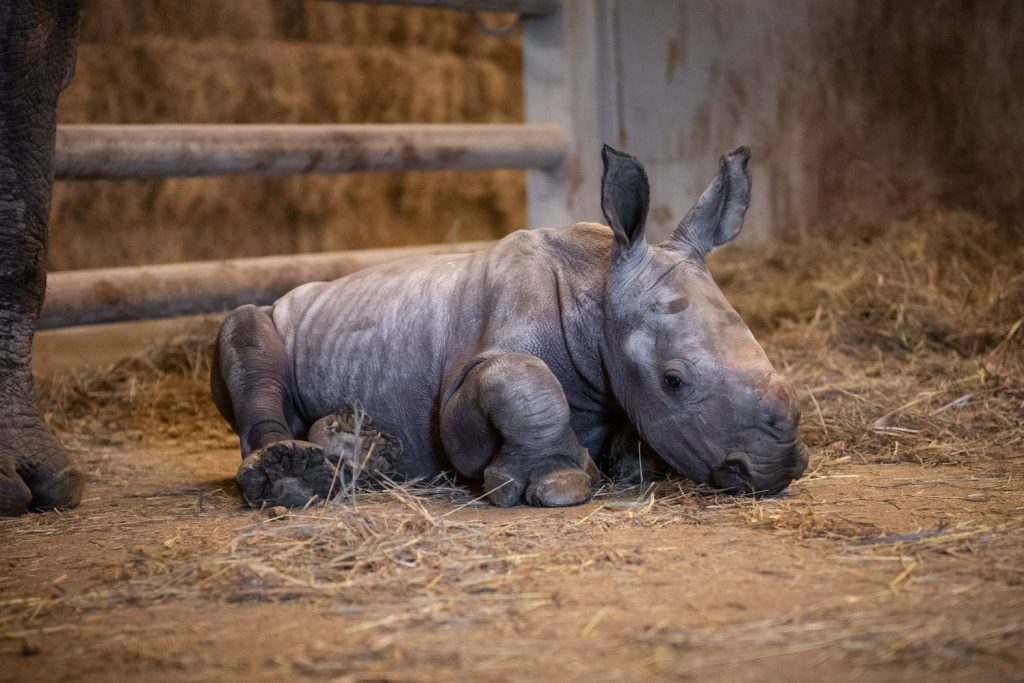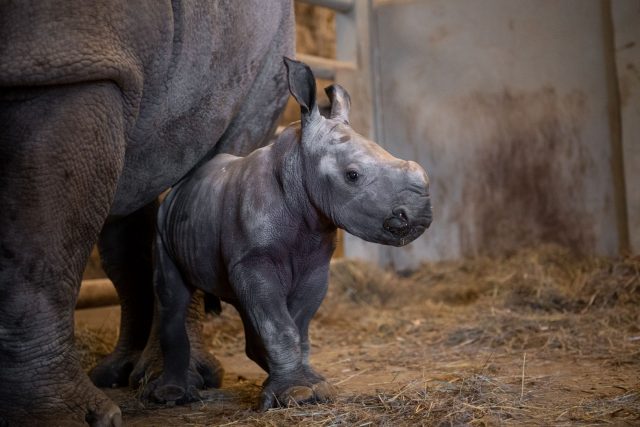Cumberland, OH – The Wilds is excited to welcome an adorable female white rhinoceros calf, who was born in the rhinos’ large, heated barn during the early morning hours of Wednesday, December 9, 2020.

The calf and her 9-year-old mother, Kifaru, who was also born at The Wilds, are doing well and continue to bond. Animal Management staff note that first-time mom, Kifaru, is being very attentive to her little one and providing her with great care. This is the fifth calf for 16-year-old father, Roscoe, who was born at the Knoxville Zoo. He moved to the Seneca Park Zoo when he was 2 years old and has been living at The Wilds since 2014.
While the calf is currently unnamed, a name will be announced soon! This calf is the 23rd white rhino to be born at The Wilds. The Wilds is the only facility outside of Africa that has had rhinos born four and five generations removed from their wild-born ancestors. That success continues with this birth. The new calf is the fifth fifth-generation white rhino born at The Wilds. Counting Asian one-horned rhinos, another species that lives at The Wilds, this calf marks the 31st rhino to be born at The Wilds since the first rhino was born at the facility in 2004.
The pairing of Kifaru and Roscoe was recommended through the Association of Zoos and Aquariums’ (AZA) Species Survival Plan® (SSP). This program is designed to maintain a sustainable population and genetic diversity of threatened and endangered species in human care. The Wilds has also welcomed the births of eight Asian one-horned rhinos since 2005. The most recent Asian one-horned rhino calf, a female named Rohini, was welcomed into The Wilds’ family on August 24, 2019.
“Wildlife conservation is a top priority for our organization, and we’re extremely proud of the contributions we’re making to help protect the future of rhinos and other threatened and endangered species. The arrival of this calf symbolizes hope and also inspires us as we’re reminded that our work is making a difference,” said Columbus Zoo and Aquarium President/CEO Tom Stalf.
“The birth of a rhinoceros calf is always cause for celebration! Rhinos continue to face many threats in their native range, and every rhino is crucial to the population. This calf joins The Wilds’ herd of important ambassadors – through them we can continue to connect our guests with these wonderful animals, and try to inspire everyone to take action to help,” said Dr. Jan Ramer, vice president of The Wilds.
The white rhino population had dwindled to an estimated 50-200 individuals at the beginning of the 20th century, but through conservation efforts, the population of white rhinos in their native range in Africa has rebounded to about 20,400 animals. However, even with the increase in numbers, the species remains classified as near threatened by the International Union for Conservation of Nature (IUCN). All five remaining rhino species in Africa and Asia (white rhinoceros, black rhinoceros, greater one-horned rhinoceros, Javan rhinoceros, and Sumatran rhinoceros) are killed by poachers who sell rhino horn for ornamental or traditional medicinal purposes even though there are no scientifically proven health benefits for its use. The horns are made of keratin—the same substance that makes up fingernails and hair. The International Rhino Foundation estimates that one rhino is killed every 10 hours for its horn.
White rhino calves are born after a gestation of 16 months and they can grow to be 4,000 pounds and six feet tall at their shoulder. Their habitats typically consist of plains or woodlands, interspersed with grassy openings. Through reintroduction efforts, their native range has been established in southern and eastern African countries.
Their physical characteristics are two pointed horns and a wide mouth suitable for grazing. The name white rhinoceros originated from the Afrikaans word describing the animal’s mouth – wyd, meaning “wide.” Early English settlers in South Africa misinterpreted the word wyd for “white.”
To further protect the future of rhinos, The Wilds and the Columbus Zoo has provided more than $218,000 in the last five years in support of conservation projects benefiting rhinos in their native ranges, such as monitoring black and white rhinos in Zimbabwe’s Lowveld region through the International Rhino Foundation, protecting black rhinos in the Ngulia Rhino Sanctuary in Kenya through the African Wildlife Foundation and habitat restoration focused on the shortgrass that white rhinos eat through the White Rhinos: Rhinoceros Fund Uganda.
Guests may have the opportunity to view the new calf, Kifaru and Roscoe, along with the other rhinos, in the rhino barn during a Winter at The Wilds Tour. Tours are available at 11 a.m. and 2 p.m. through April. Please note that reservations must be made at least 72 hours in advance.
For more information, please visit TheWilds.org and follow The Wilds’ social media accounts on Facebook, Instagram and Twitter.










